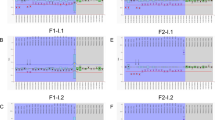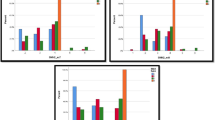Abstract
Spinal muscular atrophy (SMA) is a type of autosomal recessive genetic disease, which seriously threatens the health and lives of children and adolescents. We attempted to find some genes and mutations related to the onset of SMA. Eighty-three whole-blood samples were collected from 28 core families, including 28 probands with clinically suspected SMA (20 SMA patients, 5 non-SMA children, and 3 patients with unknown etiology) and their parents. The multiplex ligation probe amplification (MLPA) was performed for preliminary diagnosis. The high-throughput sequencing technology was used to conduct the whole-exome sequencing analysis. We analyzed the mutations in adjacent genes of SMN1 gene and the unique mutations that only occurred in SMA patients. According to the MLPA results, 20 probands were regarded as experimental group and 5 non-SMA children as control group. A total of 10 mutations were identified in the adjacent genes of SMN1 gene. GUSBP1 g.[69515863G>A], GUSBP1 g.[69515870C>T], and SMA4 g.[69515738C>A] were the top three most frequent sites. SMA4 g.[69515726A>G] and OCLN c.[818G>T] have not been reported in the existing relevant researches. Seventeen point mutations in the DYNC1H1 gene were only recognized in SMA children, and the top two most common mutations were c.[2869-34A>T] and c.[345-89A>G]; c.[7473+105C>T] was the splicing mutation that might change the mRNA splicing site. The mutations of SMA4 g.[69515726A>G], OCLN c.[818G>T], DYNC1H1 c.[2869-34A>T], DYNC1H1 c.[345-89A>G], and DYNC1H1 c.[7473+105C>T] in the adjacent genes of SMN1 gene and other genes might be related to the onset of SMA.
Similar content being viewed by others
Data availability
Data sharing is not applicable to this article as no datasets were generated or analyzed during the current study.
References
Gilliam TC, Brzustowicz LM, Castilla LH, Lehner T, Penchaszadeh GK, Daniels RJ, Byth BC, Knowles J, Hislop JE, Shapira Y, Dubowitz V, Munsat TL, Ott J, Davies KE (1990) Genetic homogeneity between acute and chronic forms of spinal muscular atrophy. Nature 345(6278):823–825
Malcov M, Schwartz T, Mei-Raz N, Yosef DB, Amit A, Lessing JB, Shomrat R, Orr-Urtreger A, Yaron Y (2004) Multiplex nested PCR for preimplantation genetic diagnosis of spinal muscular atrophy. Fetal Diagn Ther 19:199–206
Campbell L, Potter A, Ignatius J, Dubowitz V, Davies K (1997) Genomic variation and gene conversion in spinal muscular atrophy: implications for disease process and clinical phenotype. Am J Hum Genet 61(1):40–50
Russman BS (2007) Spinal muscular atrophy: clinical classification and disease heterogeneity. J Child Neurol 22(8):946–951
Brzustowicz LM, Lehner T, Castilla LH, Penchaszadeh GK, Wilhelmsen KC, Daniels R, Davies KE, Leppert M, Ziter F, Wood D, Dubowitz V, Zerres K, Hausmanowa-Petrusewicz I, Ott J, Munsat TL, Gilliam TC (1990) Genetic mapping of chronic childhood-onset spinal muscular atrophy to chromosome 5q11.2–13.3. Nature. 344(6266):540–541
Feldkötter M, Schwarzer V, Wirth R, Wienker TF, Wirth B (2002) Quantitative analyses of SMN1 and SMN2 based on real-time lightCycler PCR: fast and highly reliable carrier testing and prediction of severity of spinal muscular atrophy. Am J Hum Genet 70(2):358–368
Chen Q, Baird SD, Mahadevan M, Besner-Johnston A, Farahani R, Xuan J, Kang X, Lefebvre C, Ikeda JE, Korneluk RG, MacKenzie AE (1998) Sequence of a 131-kb region of 5q13. 1 containing the spinal muscular atrophy candidate genes SMN and NAIP. Genomics 48(1):121–127
Sneha P, Zenith TU, Abu Habib US, Evangeline J, Thirumal Kumar D, George Priya Doss C et al (2018) Impact of missense mutations in survival motor neuron protein (SMN1) leading to spinal muscular atrophy (SMA): a computational approach. Metab Brain Dis 33(6):1823–1834
Cuscó I, Barceló MJ, Rojas-García R, Illa I, Gámez J, Cervera C et al (2005) SMN2 copy number predicts acute or chronic spinal muscular atrophy but does not account for intrafamilial variability in siblings. J Neurol 253(1):21–25
Clermont O, Burlet P, Benit P, Chanterau D, Saugier-Veber P, Munnich A, Cusin V (2004) Molecular analysis of SMA patients without homozygous SMN1 deletions using a new strategy for identification of SMN1 subtle mutations. Hum Mutat 24(5):417–427
Scharf JM, Endrizzi MG, Wetter A, Huang S, Thompson TG, Zerres K, Dietrich WF, Wirth B, Kunkel LM (1998) Identification of a candidate modifying gene for spinal muscular atrophy by comparative genomics. Nat Genet 20(1):83–86
Ma H, Wang Y, Mi Z, Wu Y, Zhao P, Zhao S et al (1999) Study of NAIP gene in spinal muscular atrophy. Chin J Med Gene 16(2):97–98
Oates EC, Rossor AM, Hafezparast M, Gonzalez M, Speziani F, MacArthur DG, Lek M, Cottenie E, Scoto M, Foley AR, Hurles M, Houlden H, Greensmith L, Auer-Grumbach M, Pieber TR, Strom TM, Schule R, Herrmann DN, Sowden JE, Acsadi G, Menezes MP, Clarke NF, Züchner S, UK10K, Muntoni F, North KN, Reilly MM (2013) Mutations in BICD2 cause dominant congenital spinal muscular atrophy and hereditary spastic paraplegia. Am J Hum Genet 92(6):965–973
Boczonadi V, Müller JS, Pyle A, Munkley J, Dor T, Quartararo J, Ferrero I, Karcagi V, Giunta M, Polvikoski T, Birchall D, Princzinger A, Cinnamon Y, Lützkendorf S, Piko H, Reza M, Florez L, Santibanez-Koref M, Griffin H, Schuelke M, Elpeleg O, Kalaydjieva L, Lochmüller H, Elliott DJ, Chinnery PF, Edvardson S, Horvath R (2014) EXOSC8 mutations alter mRNA metabolism and cause hypomyelination with spinal muscular atrophy and cerebellar hypoplasia. Nat Commun 5:4287
He J, Zhang QJ, Lin QF, Chen YF, Lin XZ, Lin MT, Murong SX, Wang N, Chen WJ (2013) Molecular analysis of SMN1, SMN2, NAIP, GTF2H2, and H4F5 genes in 157 Chinese patients with spinal muscular atrophy. Gene. 518(2):325–329
Sheridan C (2018) Gene therapy rescues newborns with spinal muscular atrophy. Nat Biotechnol 36(8):669–670
Groen EJN, Talbot K, Gillingwater TH (2018) Advances in therapy for spinal muscular atrophy: promises and challenges. Nat Rev Neurol 14(4):214–224
Theodosiou AM, Morrison KE, Nesbit AM, Daniels RJ, Campbell L, Francis MJ, Christodoulou Z, Davies KE (1994) Complex repetitive arrangements of gene sequence in the candidate region of the spinal muscular atrophy gene in 5q13. Am J Hum Genet 55(6):1209–1217
Schneeberger EE, Lynch RD (2004) The tight junction: a multifunctional complex. Am J Phys Cell Phys 286(6):C1213–C1228
Osanai M, Murata M, Nishikiori N, Chiba H, Kojima T, Sawada N (2006) Epigenetic silencing of occludin promotes tumorigenic and metastatic properties of cancer cells via modulations of unique sets of apoptosis-associated genes. Cancer Res 66(18):9125–9133
Abdel-Hamid MS, Abdel-Salam GMH, Issa MY, Emam BA, Zaki MS (2017) Band-like calcification with simplified gyration and polymicrogyria: report of 10 new families and identification of five novel OCLN mutations. J Hum Genet 62(5):553–559
Arun V, Worrell L, Wiley JC, Kaplan DR, Guha A (2013) Neurofibromin interacts with the cytoplasmic dynein heavy chain 1 in melanosomes of human melanocytes. FEBS Lett 587(10):1466–1473
Zheng Z, Wan Q, Liu J, Zhu H, Chu X, Du Q (2013) Evidence for dynein and astral microtubule–mediated cortical release and transport of Gαi/LGN/NuMA complex in mitotic cells. Mol Biol Cell 24(7):901–913
Roberts AJ, Kon T, Knight PJ, Sutoh K, Burgess SA (2013) Functions and mechanics of dynein motor proteins. Nat Rev Mol Cell Biol 14(11):713–726
Sucularli C, Arslantas M (2017) Computational prediction and analysis of deleterious cancer associated missense mutations in DYNC1H. Mol Cell Probes 34:21–29
Ahmad-Annuar A, Shah P, Hafezparast M, Hummerich H, Witherden AS, Morrison KE, Shaw PJ, Kirby J, Warner TT, Crosby A, Proukakis C, Wilkinson P, Orrell RW, Bradley L, Martin JE, Fisher EM (2003) No association with common Caucasian genotypes in exons 8, 13 and 14 of the human cytoplasmic dynein heavy chain gene (DNCHC1) and familial motor neuron disorders. Amyotroph Lateral Scler Other Motor Neuron Disord 4(3):150–157
Vissers LE, de Ligt J, Gilissen C, Janssen I, Steehouwer M, de Vries P et al (2010) A de novo paradigm for mental retardation. Nat Genet 42(12):1109–1112
Harms MB, Ori-McKenney KM, Scoto M, Tuck EP, Bell S, Ma D et al (2012) Mutations in the tail domain of DYNC1H1 cause dominant spinal muscular atrophy. Neurology 78(22):1714–1720
Niu Q, Wang X, Shi M, Jin Q (2015) A novel DYNC1H1 mutation causing spinal muscular atrophy with lower extremity predominance. Neurol Genet 1(2):e20
Garrett CA, Barri M, Kuta A, Soura V, Deng W, Fisher EM et al (2014) DYNC1H1 mutation alters transport kinetics and ERK1/2-cFos signalling in a mouse model of distal spinal muscular atrophy. Brain 137(Pt 7):1883–1893
Funding
This work was supported by the Program of Tianjin Science and Technology Plan (No. 18ZXDBSY00170), the Key Project of Tianjin Health Care Professionals (No. 16KG166), and National Natural Science Foundation of China (No. 81771589).
Author information
Authors and Affiliations
Contributions
Conceptualization: Chunquan Cai and Jianbo shu. Formal analysis: Yulian Fang. Methodology and investigation: Na Li and Xiufang Zhi. Interpreted data: Jie Zheng and Yang Liu. Writing—original preparation: Chunquan Cai. Writing—review and editing: Jianbo Shu, Linjie Pu and Chunyu Gu. Supervision: Chunquan Cai. All the authors read and approved the final manuscript.
Corresponding authors
Ethics declarations
Ethics approval and consent to participate
The parents included in our research all had informed consents, and the study was approved by the medical ethics committee of Tianjin Children’s Hospital.
Consent for publication
We have obtained consent to publish from the participants’ parents to report individual patient data.
Conflict of interest
None.
Additional information
Publisher’s note
Springer Nature remains neutral with regard to jurisdictional claims in published maps and institutional affiliations.
Rights and permissions
About this article
Cite this article
Fang, Yl., Li, N., Zhi, Xf. et al. Discovery of specific mutations in spinal muscular atrophy patients by next-generation sequencing. Neurol Sci 42, 1827–1833 (2021). https://doi.org/10.1007/s10072-020-04697-8
Received:
Accepted:
Published:
Issue Date:
DOI: https://doi.org/10.1007/s10072-020-04697-8




